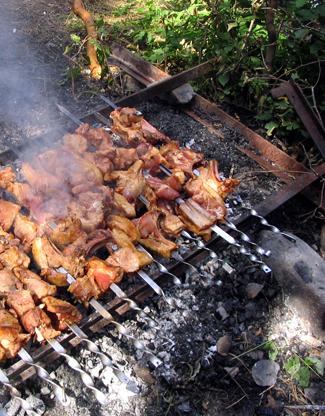 A car drives up. Someone opens the trunk. I see what’s inside. Oh, no . . .
A car drives up. Someone opens the trunk. I see what’s inside. Oh, no . . .
Do you like picnics? Barbecues? Sure you do. If you live in the world of gourmet supermarkets, supermercados, supermercati or similar food meccas, you’ll find everything you’ll need, all hygienically packed and wrapped — beautifully manicured cuts of meat, triple-washed salad greens, freshly made deli foods by the pound, pre-cut veggies and fruits. Etc., etc.
I didn’t know what a “real” barbecue was until I lived in Armenia, land of the khorovats, extreme barbecue. Now that I live in Moldova where barbecue is not elevated to magical heights, I long for an Armenian barbecue. Let me tell you about one such an Armenian eat fest, but be warned, this story is . . .
Not For the Squeamish!
Along with several of our Armenian friends, we’ve been invited to a khorovats-picnic at the dacha of a business acquaintance. The dacha, or summer house, is located in the country.
Dacha: Are you thinking that dachas are fancy summer houses of Russian politicians, somewhere along the Black Sea? Well, yes, they can be that. A dacha can also be a more modest structure, say a ramshackle cottage, or a rusty old fuel tank, the kind that is used by gas stations. I didn’t know this either, so don’t feel bad.
It’s still early when we arrive at our destination, a serene plot of land mostly taken up by an unkempt orchard and a garden overrun with weeds. Our host, Mr. A., has been indisposed and not been able to keep the place up, much to the enjoyment of wild flowers, which are blooming in lush profusion. It all looks lovely and serene, oblivious to things unserene yet to come
The dacha is of the rusty fuel tank variety. It is divided in 2 rooms, one with a small fridge, the other with a bed.
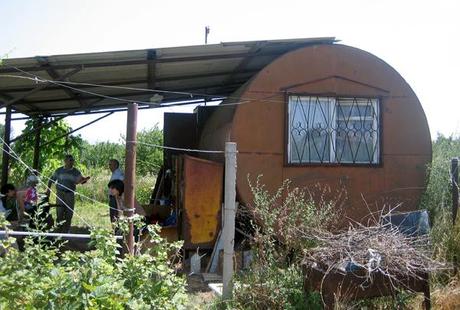
There is electricity and a water spigot outside. The dacha has a history: It was once used as a domik, to house people left homeless after the devastating earthquake of 1988.
Further afield the facilities are located, an outhouse with a hole in the ground. Two of the walls consist of a blue tarpaulin, flapping cheerily in the breeze and possibly offering interesting views of what goes on inside.
We are offered homemade yogurt to hold us over till the real food is cooked and we take off to forage in the orchard for fruit. And that’s when I notice the car driving up. Someone opens the trunk. I see what’s inside. Oh, no . . . .
And if you are thinking I’m seeing grocery bags full of victuals purchased at a supermarket, you would be wrong.
There’s a live sheep in the back, a filthy animal, its legs tied. It’s dropped on the ground under a bush, where it squirms around and chews on some grass. What a sad spectacle.
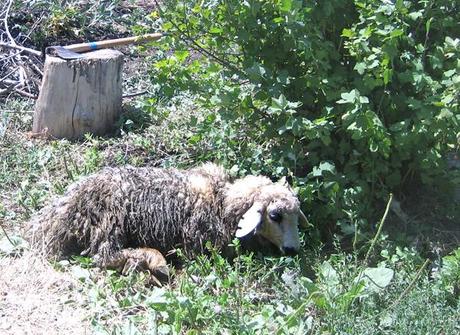
I turn away, and entertain myself talking to Davit. He’s an adorable five-year-old, all eyes and ears, skinny and super bright. He loves playing war games with toy tanks and toy soldiers. Davit also takes karate lessons. He demonstrates some moves for our entertainment.
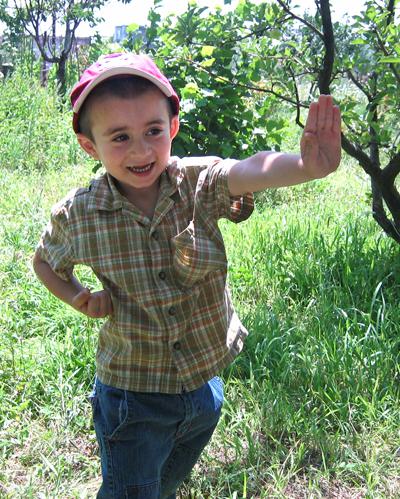
To See or Not to See
Later I see a young man with several knives in his hands looking down on the poor sheep under the tree.
Davit is taken away further into the orchard by his mother. I follow her, not wanting to be a witness to slaughter. Not much later as I walk back, I see the sheep hanging by one of its legs from a tree trunk. Its head is gone, its neck a bloody stump dripping blood on the grass. (I’ll spare you the photo.) The young man starts his work, taking off the skin, and I am out of there.
A fire is started in the barbecue. Tomatoes, peppers, and eggplants are washed and cut up ready to be part of the feast. Skewers the size of fencing rods appear. I keep walking back and forth to the butchery scene, wanting to see and not to see.
Hunks of meat and fat, and what looks like various intestinal stuff and organs are cut up and put onto skewers and placed on the fire. The first load is the liver, kidneys and spleen and once it’s roasted we’re invited to have a piece. I tell them I’m saving space for the rest of the meal. Which is the truth, really. I mean I’m an adventurous eater and all, but I’m just not that hungry yet. With the first of these delicate bites, a toast is made with vodka or brandy. I take a small glass of brandy and sip it carefully. I know how many more toasts are ahead of me. This is, after all, Armenia
Next the actual sheep meat is put in a big cooking pot with salted water and somewhere in the orchard a fire is built where the meat will cook for several hours.
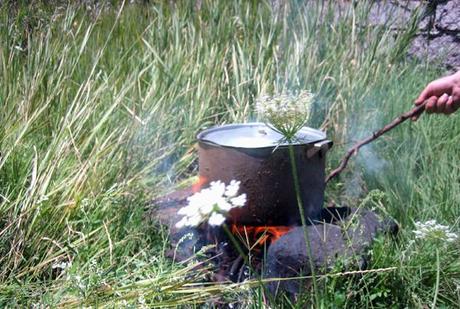
Armenians do not prefer barbecued lamb if there is a choice. Pork is what they want on the fire. Fortunately no pig is slaughtered in front of us and the meat arrives already butchered. Enormous chops and other chunks of pork are skewered and placed on the barbecue along with chunks of aubergine/eggplant alternated with hunks of sheep’s fat.
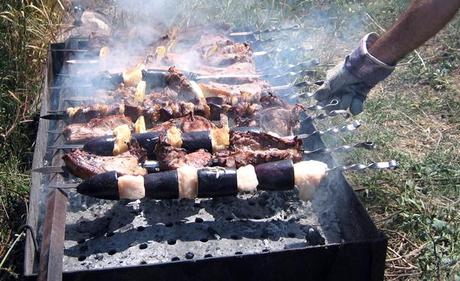
Let’s Set the Table
Am extreme table is made ready, an old metal thing that is not big enough for us all, so an old door is added on and propped up with on old box and a crate full of empty soft drink bottles. A motley collection of cloths are draped over the table, and benches are covered with old blankets and throws. Rickety chairs are added, and voila, there’s room for everybody to sit. I love this sort of making do. It feels so . . . real.
The food is brought to the table. The host’s son is newly married and his bride is rushing back and forth like she runs on batteries, her face expressionless. Don’t worry, one of our friends says to us, she is earning her points as the new daughter- in-law. As is the custom, she and her husband live with her in-laws. This is, after all, Armenia.
The table is full of dishes – pork, bread, peeled roasted tomatoes, fresh tomatoes, dishes of salt, cut up lemons, and of course the usual forest of bottles.
Let’s Toast!
And then comes the toasting. Everybody takes a turn in between bites. Toasts to the glories of Armenia, the glories of friendship, to the beauty of the women, the health of the children, and so on and so forth, ad infinitum. This is, after all, Armenia
We eat pork, we eat vegetables. Then we sit around for a while enjoying more toasts and more drinks. There’s time between courses so I wander around for a bit, then join my friend Anna and Davit. I manage to crush some cut up flower heads under my feet, but no problem: The blooms had been soldiers in a war orchestrated by Davit – the purple clover blooms were the bad guys, the white flowers the good guys. The war is over and all are dead, even more so now that my feet have stomped all over them.
What about the boiled sheep, you wonder? Here it comes: shapeless hunks heaped on big plates.
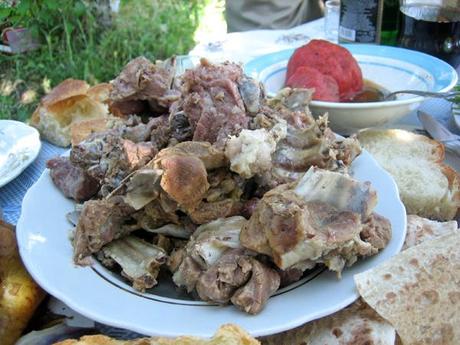
The meat has been cooking for several hours and is falling off the bone. I try not to think of the stupid look in the sorry sheep’s eyes as I eat it. It is quite tasty. We sit around some more, offer up more toasts, drink more vodka, brandy or wine.
Enough now, you’re thinking? Oh, no, this is an Armenian khorovats, so . . . .
Here Comes the Fish!
The fish: Barbecued whole trout. A bit on the dry side – the fire maybe too hot. We are all stuffed. I am toasted out, brandied and vodka-ed out. The wind is getting rather strong and I am getting a bit coolish in my little cotton shirt and short denim skirt. But the party is not over yet.
The Dessert!
Here come the apples, the peaches, the cherries, the water melons, followed by a box the size of a coffin full of bakery pastries. Enough, you think? Certainly not.
There’s More!
Ice cream cake! A big one! And we MUST have some. Coffee arrives. Thick and muddy, the way it is supposed to be here in Armenia.
Finally, we roll out of there. I am tired, full, finished. Man, oh man, this is what you call a barbecue.
Such a wonderful day we’ve had, a true cultural experience with friends and food. Such a lovely setting, such peace and quiet spent among the fruit trees and the flowers.
Yes, such an idyllic place, but in the course of this day a sheep was slaughtered and five-year-old Davit fought a war where all the soldiers perished.
* * *

